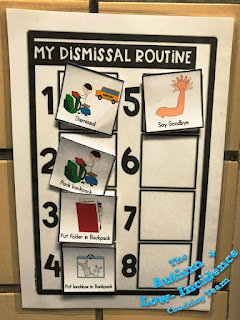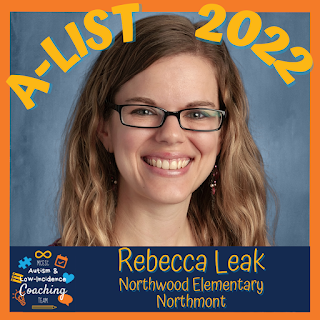This month we are so excited to feature Rebecca Leak who is an Intervention Specialist at Northwood Elementary in Northmont. During our time working with Rebecca, were so impressed with how well she collaborated with colleagues and parents for an individual student. She adapted to changing expectations during remote instruction and then really allowed this student to soar with her co-planning for meaningful inclusion opportunities during in-person learning. Her dedication, time, and hard work were definitely noticed! She shows great initiative in meeting the unique needs of individual students and we feel Rebecca is a great role model for others!
We recently asked Rebecca to share some of her favorite supports from her classroom. Rebecca shared,
Flexible Seating
I have a lot of wiggly students, so I incorporate a lot of movement breaks in my classroom. I have a small trampoline and utilize tools like GoNoodle. In addition, I have found that flexible seating helps students get sensory input while also staying focused. A few examples of this are: rocking chairs, tilty stools, kick bands, and wobble seats. I also have a standing desk to use when needed.

Visual Supports
Many students, especially the younger ones, struggle with prolonged attention and focus. I frequently use visual timers to let them know how long I expect them to work. In addition to this, I often use a first/then chart. I've made rewards and activities based on student likes and preferences. Before we start, I let them choose one reward to work towards and then set the visual timer so they know how long they have to work before earning their reward. When focus is an extra struggle, I use the token board so they can visually track their progress through our activity time.
Daily Calendar and Math Practice
My students need constant review and spiraling of concepts, especially in math, so I have a daily calendar time where I incorporate repetitive practice and review of basic skills. In addition to months, weeks, and days, we keep track of how many days we have been in skill while also practicing skills like place value, writing and reading numbers, marking with tallys, rote and skip counting, telling time, identifying coins by name and value, as well as counting coins and writing the amount using the appropriate sign.
Independent Work
There are often times, in my resource room, where students need to work independently while staff are busy with other groups. Independent work can be a huge challenge for my students. Sometimes they can work on their iPads, but often that is too much of a distraction and temptation. So, I have many independent folder activities that cover a wide variety of skills in ELA and math. They are picture based and often more engaging for students. I can pick a skill that I know they have mastered enough to to do on their own and it gives me time to work with other students while they are still practicing meaningful skills.
Edible Reinforcers
Student motivation is a constant consideration in my classroom, as I work with students who are highly distractible and struggle to attend to tasks for an extended period of time. My students seem to be most motivated by food and candy, but I discovered that offering them a piece of candy at the end of a 15 or 20-minute work session was often too far off to be a tangible and real motivation. So I have started keeping food and treats around that come in much smaller portions. Some of my students favorites are the chocolate chips and mini marshmallows. I also use cereal or mini pretzels. Anything delicious and tiny! When working, it is much easier for them to keep track of their success and stay motivated when they are receiving a small reward every 3-5 minutes as opposed to every 15-30. I do not use this every time we work (I don't want it to become the only reason they work), but on difficult days or during especially frustrating tasks, it has been very helpful!"

Thank you so much to Rebecca for sharing these wonderful ideas and welcoming us into her classroom! It was a pleasure working with you and seeing how you help your students thrive!





































